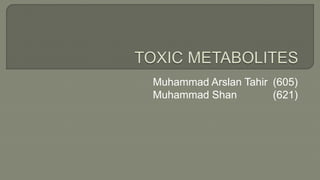
Toxic Metabolites and Mechanisms of Drug-Induced Liver Injury
- 1. Muhammad Arslan Tahir (605) Muhammad Shan (621)
- 2. Toxicology: The branch of science concerned with the nature, effects, and detection of poisons. Toxicology, the study of toxicity, is situated at the border of chemistry, biology, and in some cases.
- 3. Metabolic conversions of drugs required for therapeutic effect, whether biotransformation lead to the formation of toxic metabolites or to variations in therapeutic effects. It depends on intrinsic: (such as the genetic polymorphism of some metabolism pathways) extrinsic: (such as the dose, the route or the duration) factors.
- 4. Biotransformation begins with the transient formation of a reactive intermediate, whose lifetime is long enough to allow an attack on cellular components. This occurs when a reactive intermediate (generally radicals or electrophiles such as a carbonium ion) is formed and reacts rapidly with cellular macromolecules (such as unsaturated lipids, proteins, nucleic acids…), thus leading to their degradation and finally to cellular necrosis.
- 5. Examples of drugs that produce toxic metabolites: 1) Isoniazid 2) Chloramphenicol 3) Acetaminophen 4) Chloroform 5) Sulphathiazole
- 6. Isoniazid (INH) is highly effective for the management of tuberculosis. However, it can cause liver injury and even liver failure. INH metabolism has been thought to be associated with INH-induced liver injury.
- 7. Mechanism of toxicity: • Isoniazid undergoes acetylation to form acetylisoniazid • Acetylisoniazid undergoes hydrolysis and breaks down into isonicotinic acid and acetylhydrazine • Acetylhydrazine is an acetylating agent that causes hepatotoxicity.
- 9. Chloramphenicol is an antibiotic. Mechanism of toxicity: • Chloramphenicol is oxidized by CYP monooxygenase to chloramphenicol oxamyl chloride formed by the oxidation of the dichloromethyl moiety of chloramphenicol followed by elimination of hydrochloric acid . • The reactive metabolite reacts with the -amino group of a lysine residue in CYP 15.
- 10. • Inhibits the enzymatic reaction progressively with time. • This type of inhibition is a time-dependent inhibition or a mechanism base inhibition or inactivation, and the substrate involved historically has been called a suicide substrate because the enzymatic reaction yields a reactive metabolite, which destroys the enzyme.
- 12. Belongs to the class ‘NSAIDs’ Widely used for analgesic and antipyretic activity Hepatotoxicity due to formation of highly active metabolite NAPQI (N-acetyl-p-benzoquinone imine)
- 13. Metabolism After therapeutic doses: • Glucuronide conjugates (52-57%) kidney + liver • Sulfate conjugates (30-44%) kidney • NAPQI (5-10%) • Excreted unchanged (<5%)
- 14. NAPQI Mostly formed in the liver, a little in kidney Highly reactive Primarily responsible for hepatotoxicity Detoxification: • Binding to sulfhydral group of glutathione (GSH) • Excretion through urine as cysteine and mercapturic acid conjugates
- 15. After supratherapeutic doses: • Sulfation pathway becomes saturated • Glucuronidation and oxidation increases • Excretion as unchanged also increases After highly toxic doses: • Glucuronidation also gets saturated • Elimination as unchanged increases (~10%) • Oxidation to NAPQI (>15%)
- 16. Excess NAPQI: • Depletes GSH Stores • Starts to form protein adducts through binding to cysteine groups on cellular proteins NAPQI primarily targets mitochondrial proteins and ion channels leading to • the loss of energy production • ion misbalance • cell death
- 18. Belongs to the class of ‘General Anaesthetics’ Chemically ‘trichloromethane’ (an alkyl halide) Once widely used as inhalation anaesthetic Not used nowadays due to toxic effects on heart and liver
- 19. Mechanism of toxicity: • Chloroform undergoes CYP-mediated oxidation to trichloromethanol • The unstable trichloromethanol loses HCl and form phosgene gas (COCl2) which is highly reactive • Phosgene causes oxidative stress, cell damage/death.
- 21. Synthetic antibacterial agent Belongs to the class of ‘Sulphonamides’ Perform its action by dihydropteroate synthetase inhibition Rarely prescribed nowadays due to higher incidence of associated adverse drug reaction and toxicity
- 22. Mechanism of toxicity: • Sulphathiazole is metabolized by N-acetylation • N-acetylation increases hydrophobic character • Reduces solubility • Resultant metabolite can prove fatal if blocks kidney tubules May cause: • Crystalluria • Kidney failure
